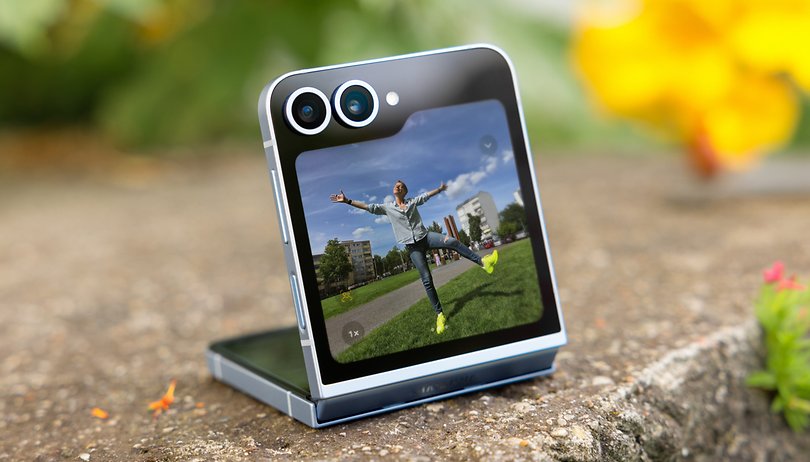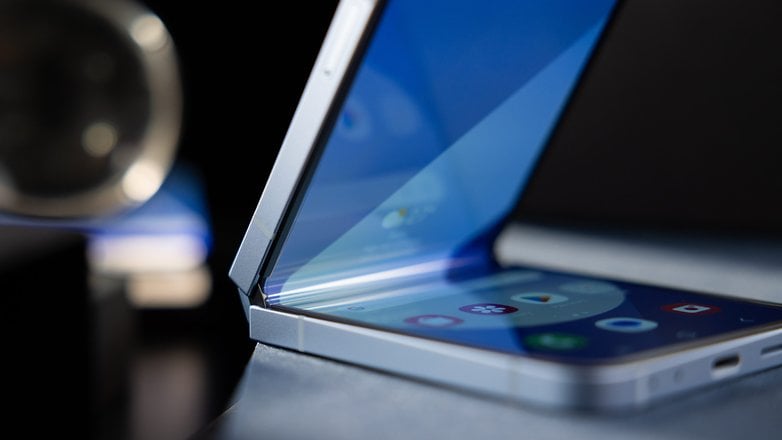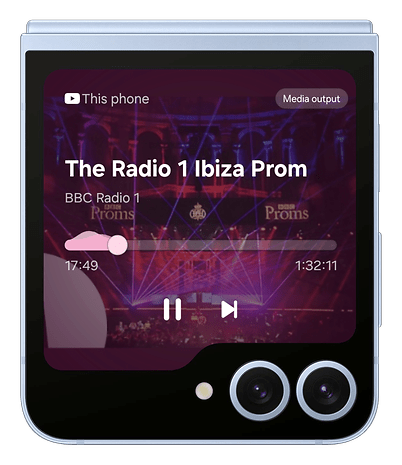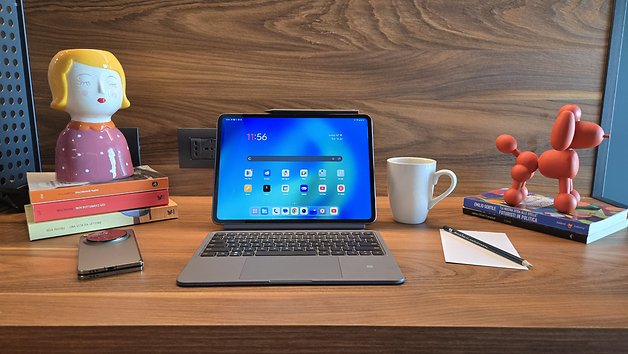Samsung Galaxy Z Flip 6 Review: Smarter, Better, Faster, Stronger!


My initial thoughts about the Galaxy Z Flip 6 were confirmed after using it for a long time: it's smarter, better, faster, and stronger. But is this new pocket-friendly phone from Samsung worth the price? Here's our detailed review of the Galaxy Z Flip 6.
Good
- Durable design with IP48 dust resistance
- Seven years of software updates
- Excellent performance with Snapdragon 8 Gen 3
- Improved 50MP main camera
- All-day battery life
Bad
- 10% more expensive, starting at $1,099
- Difficult one-handed use
- The outer display lacks app support
- The camera struggles with dynamic range
- Slow recharge, no charger included

Price & Availability
First things first: the new Galaxy Z Flip 6 is 10% more expensive this year. One would think that with the sixth generation, this device would be cheaper, but with the hardware upgrade and the Galaxy AI integration, Samsung increased the price of its flip phone.
The Z Flip 6 will be available for $1,099 with 12 GB of RAM and 256 GB of internal memory. And if you decide to buy the Z Flip 6 at the Samsung e-store, you will have the option to choose one of these three exclusive colors: Crafted Black, White, or Peach.
Design & Display: Stronger
I've tested the last three Z Flip models, and it seems like Samsung is making them more durable over time. The latest version has a more square design and feels sturdier when held. It is also stronger, now featuring dust resistance certification, and its inner display peak brightness has increased from 1750 nits in 2023 to 2600 nits in 2024 .
Pros:
- IP48 certification.
- Nice variety of colors.
- Inner display is brighter and colorful.
- The crease in the screen is even more subtle.
Cons:
- The flip concept fails when using the device with one hand.
- No new features compared to the previous generation.

Aside from the IP48 rating and new color options, the Flip's overall look hasn't changed much. However, when you hold it, it feels more substantial—in a good way, indicating durability and quality rather than just heaviness. So, even though the appearance is basically the same, it feels better.
One thing to note is that it's almost impossible to open the Z Flip with one hand, which goes against the whole flip phone concept, right? In this regard, I think the Razr Plus 2024 does a better job. Although I didn't get to use the new Motorola flip phone for a long time, my brief experience with it strongly suggested that its more rounded design is easier to handle single-handedly.
- Beyond the Hinge: Read our Galaxy Z Flip 5 review

Moving on, the Galaxy Z Flip 6 features a 6.7-inch main display with a 22:9 aspect ratio and an AMOLED screen. This is a colorful and large display, showcasing Samsung's expertise as a display manufacturer. With a variable refresh rate ranging from 1Hz to 120Hz, the Z Flip 6 is great for consuming content and browsing on the internet.
Furthermore, this time around, the crease is much more subtle, we almost don't even feel it. But how about the outer display?

To be honest, nothing has really changed in this area. The front display still has the same 3.4-inch Super AMOLED panel with a 60Hz refresh rate. What I like the most is that Samsung allows extensive customization options and lets us interact with apps, messages, and games. However, it's not the largest outer display available.

Software & User Interface: Smarter
The Z Flip 6 runs on Android 14 with Samsung's One UI 6.1.1 overlay. Samsung promises seven years of software updates, including seven Android upgrades, ensuring long-term support and security. This commitment to updates is a significant advantage for users looking for longevity in their device .
Pros:
- Seven years of Android and security updates.
- One UI 6 is highly refined at this stage.
- Galaxy AI features are nice additions.
Cons:
- The outer display software needs more third-party apps.
One advantage of flip devices is the ability to interact with the system while in the flip position—Samsung calls this FlexWindow. Despite the manufacturer's efforts to improve it, the outer display software still needs more support from third-party developers. So far, Samsung hasn't been able to motivate them to fully embrace the flip functionality.
At this point, the secondary screen is mostly filled with widgets rather than apps. However, we can still do some cool things like playing games, watching YouTube videos, using the calculator, and replying to messages. But again, there's nothing really new compared to last year, except for one really useful feature: the interpreter.
As expected, Samsung has brought Galaxy AI features to the Flip 6. We've already shown you how to use some of these smart features on your Galaxy devices. My colleague, Antoine Engels, highlighted some of the new additions to the Fold and Flip series in his Galaxy Z Fold 6 review, so I suggest you check it out.
However, I want to highlight the relevance of the Interpreter feature on the Z Flip 6, as I believe this service makes the device a must-have for world travelers. The Interpreter is not an app but a system option found in the quick settings menu. It took me a while to find it—around 10 minutes—so I don't think it's the most intuitive presentation.
That said, it works well and is easy to use. However, I don't recommend using it in crowded places like bars because it picks up other people's conversations and mixes topics. Trust me, it happened to me. This feature is great because it allows real-time conversations, which is still hard to achieve in 2024. Even dedicated devices like the Timekettle X1 AI Interpreter Hub (review) struggle with this.
Additionally, the Galaxy Z Flip 6 includes features like AI Drawing, which can add creativity to our photos. Samsung is doing a good job in this area.

Performance & SoC: Faster
Under the hood, the Galaxy Z Flip 6 is powered by the Qualcomm Snapdragon 8 Gen 3 for Galaxy, paired with 12 GB of RAM, and offers two storage options: 256 GB and 512 GB. The hardware performed well, and despite frequent overheating, it didn't negatively impact the device's performance. The new vapor chamber introduced with the Z Flip 6 does a good job of heat dissipation and thermal management .
Pros:
- Unquestionable performance.
- Thermal management works.
Cons:
- -

In addition to the software layers in One UI, the brighter inner display, and dual screens, the Z Flip 6 can handle many AI features. Those services require a lot of energy, real-time processing, and data.
For instance, the new Auto Zoom photo feature in Flex Mode needs the Snapdragon 8 Gen 3 to perform plenty of calculations in real-time. This involves working with the Image Sensor Processing (ISP), Neural Processing Unit (NPU), data from two cameras, and the outer screen. Since AI processing is done on the device, at least the modem is not involved.
All these processes require lots of computing power, putting a heavy load on the hardware. Despite this, the Z Flip 6 performs solidly, making this compact device work at its best.
| Samsung Galaxy Z Flip 6 (Snapdragon 8 Gen 3) |
Samsung Galaxy Z Flip 5 (Snapdragon 8 Gen 2) |
Motorola Razr+ 2023 (Snapdragon 8+ Gen 1) |
|
|---|---|---|---|
| 3D Mark Wild Life Extreme | 4,892 | 3,342 | 2,803 |
| 3D Mark Wild Life Extreme Stress Test |
Best loop: 4,735 Worst loop: 1,815 |
- | Best loop: 2,803 Worst loop: 1,222 |
| AnTuTu | 1,456,322 | - | - |
| Geekbench 6 | Single: 2,259 Multi: 6,915 |
Single: 1,988 Multi: 5,086 |
Single: 1,303 Multi: 3,712 |
Finally, during my test with the Z Flip 6, the AI features were the most demanding, and the device handled them well. Everything else ran smoothly, which is expected for a device that costs over $1000.
Camera: Better
The Galaxy Z Flip 6 has a reliable camera, which I used for professional tasks during testing. It captures images with good contrast and depth. However, it struggles with dynamic range, moving subjects, and occasional hand shakes, leading to less sharp images. You might need to take multiple shots to get a clear picture .
Pros:
- Overall, the image quality is good in well-lit conditions.
- Night shots are Instagrammable.
- Camcorder Grip feature is neat.
Cons:
- The ultra-wide-angle camera has significant edge distortion.
- Dynamic range needs improvement.
- Auto-zoom for well-framed objects doesn't work as expected.

The sixth generation of the Flip has a camera similar to the one in the Galaxy S24 (review), featuring a 50-megapixel sensor that takes 12MP images by default. The ultra-wide-angle camera has a 12-megapixel sensor, while the front camera offers 10 megapixels—but due to the flip design, it makes sense to use the main camera for selfies.
I've tested the last three generations of Flip models, and this one definitely has a better camera. In good lighting, images are mostly sharp and vibrant, with nice colors and details. At night, the new sensor helps capture more light. However, Samsung's software sometimes overprocesses and oversaturates images, making them look flat or overexposed.
The highlight of my experience with the Galaxy Z Flip 6 camera was using it for my daily tasks as a journalist. While covering the release of the OnePlus Pad 2 (review) and OnePlus Watch 2R (review), I used the Z Flip 6 to take pictures and videos of the devices. For the Watch 2R, I had to use Pro mode because the camera's shutter speed wasn't compatible with the watch's refresh rate. Thankfully, Samsung provided this advanced option.
Additionally, the 50-megapixel sensor supports a 2x optical-quality zoom, and AI-assisted capabilities allow for up to 10x zoom. Personally, I wouldn't use more than 2x zoom for distant objects. However, the new sensor does bring more versatility to this model by improving the quality of cropped images, since the Galaxy Flip Series doesn't have a telephoto camera.
The camera app has a new feature called Camcorder Grip, which offers better control and stability when recording videos with the phone at a 90º angle. This feature makes one-handed use easier, and it's quite cool. The video quality is good, allowing you to record up to 4K at 60fps.
Lastly, Samsung introduced a new vapor chamber cooling system designed to maintain high performance during intensive tasks. One of these tasks is the AI-supported auto-zoom feature, which consistently keeps subjects well-framed.
This feature works when the device is in the FlexCam position, automatically reframing the main object to fit into the image. However, most of the time, it didn't work well for me and caused the phone to overheat, especially the top half where the camera and chipset are located.
If you want to see the complete image gallery for this Galaxy Z Flip 6 review, click here.
Battery life & Charging
The Z Flip 6 has a 4,000 mAh battery, which supports 25W wired charging and 15W wireless charging. This is a 300 mAh increase in battery capacity compared to the previous generation .
Pros:
- All-day battery life.
- Wireless charging is supported.
Cons:
- Slow recharge process.
- No charger is included.

In our battery life benchmark test, the Samsung Galaxy Z Flip 6 lasted 14 hours and 18 minutes before dropping below 20% charge. That's a solid performance. In real-life use, the device provided what I call an “all-day battery life.” This means you can charge it overnight, go through your daily routine, and still have a decent amount of battery left when you get home.
When it comes to charging, Samsung doesn't include a 25W adapter in the box. So I used my MacBook 61W USB-C power adapter to charge the Z Flip 6, as it’s the one I carry while traveling or working, and it charges almost all my devices. However, the results were disappointing. On average, it takes about 2 hours for the Z Flip 6 to charge from 0 to 100%.
| Samsung Galaxy Z Flip 6 (4,000 mAh | 25 W) |
|
|---|---|
| 5 min |
|
| 10 min |
|
| 20 min |
|
| 30 min |
|
| 1 h |
|
| Full charge |
|
Samsung Galaxy Z Flip 6 technical specifications
| Specifications | |
|---|---|
| Device | Samsung Galaxy Z Flip 6 |
| Image |  |
| Display | Main display: 6.7-inch | 22:9 | Dynamic AMOLED 2x (2,640 × 1,080 pixels) | FHD+ | 1 to 120Hz Front display: 3.4-inch | Super AMOLED (720 × 748 pixels) | 60 Hz | 306 PPI |
| SoC | Qualcomm Snapdragon 8 Gen 3 for Galaxy |
| Memory | 12 GB LPDDR5X RAM | 256 / 512 GB internal storage |
| Software | Android 14 with One UI 6.1.1 Seven Android upgrades Seven years of software updates |
| Rear camera | Main: 50 megapixels | 1.0 µm | f/1.8 aperture | FOV: 85˚ | OIS | Dual Pixel AF Ultra-wide angle: 12 megapixels | 1.12 µm | f/2.2 aperture | FOV: 123˚ |
| Front camera | 10 megapixels | f/2.2 aperture | FOV: 85˚ |
| Battery | 4,000 mAh 25 W wired charging 15 W wireless charging 4.5 W reverse charging |
| Connectivity | 5G, LTE, eSIM, Wi-Fi 6E (2.4 / 5 / 6 GHz), Bluetooth 5.3, USB Type-C, GPS |
| IP | IP48 |
| Colors | Silver Shadow, Yellow, Blue, Mint Online exclusive (e-store): Crafted Black, White, Peach |
| Dimensions | Closed: 71,9 × 85,1 × 14.9 mm Open: 71,9 × 165,1 × 6.9 mm |
| Weight | 187 g |
Conclusion
The sixth generation of the Galaxy Z Flip is a better device, though there are still areas for improvement, such as further developing the front display software and reducing the reliance on post-processing for the camera. Charging times could also be enhanced.
However, the Z Flip 6 boasts a faster processor for handling AI, a larger battery capacity, and a higher-resolution camera. And upgrades cost more.
The Z Flip 6 remains expensive, even in its sixth generation, making it challenging to justify its position in the $1000 range, where better camera performance is often expected. Yet, for flip phone enthusiasts, the Flip 6 stands out as one of the most refined options currently available.
It's worth noting that Samsung devices often receive significant discounts a few months after release. Additionally, many carriers will offer this pocket-friendly device with accessible contracts, making it likely that many will opt for it.





































































